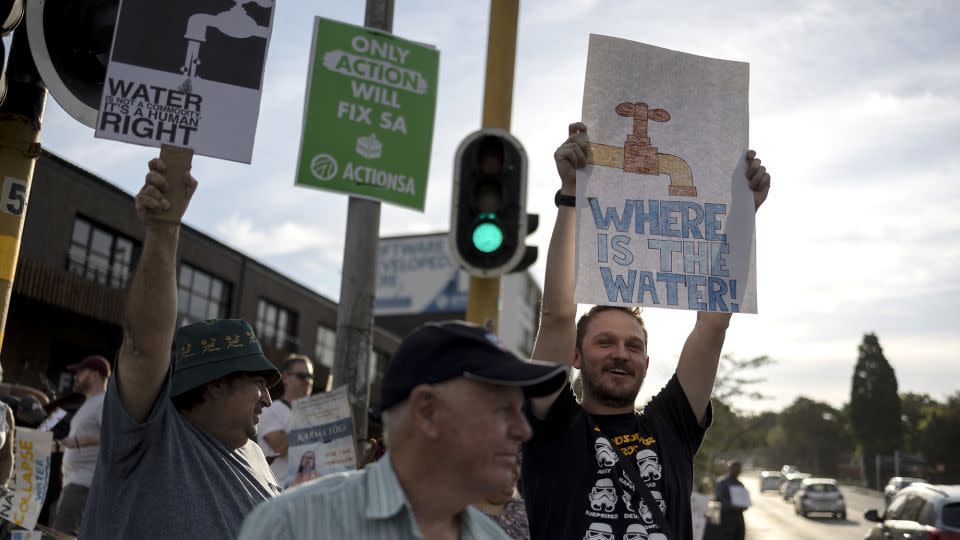Taps running dry have become part of daily life in South Africa’s biggest city
When Duane Riley turns on his taps, they shudder loudly from the air flowing through the pipes. There’s often no water trickling at all.
It’s ironic, because Johannesburg, South Africa’s biggest city, has plenty of water at the moment — authorities and water companies just can’t seem to get it to where it’s needed.
“There have been times where we’ve had no water, but I’ve had a river gushing down my driveway, because there was a leak at the top of our street,” Riley told CNN. It took authorities 14 days to fix it, he said.
Joburgers — as residents here call themselves — are no strangers to water scarcity. South Africa is naturally dry, and the climate crisis has hit the nation many times with crippling drought.
Johannesburg is one of many of the world’s big cities that are dealing with a perfect storm of crumbling critical infrastructure, lack of maintenance, corruption and insufficient planning for population growth.
While drought can hurt the city’s reservoirs, the dams are currently full, authorities say. But climate change is making things worse in another way — officials say a weeks-long heat wave is boosting water demand in enormous volumes. In February, Southern Africa saw temperatures of 4 to 5 degrees Celsius (around 7 to 9 degrees Fahrenheit) above average.
At around 9 p.m., Riley’s home typically loses water until around six in the morning.
“But there have been multiple times where we’ve been without water for five, seven days,” he said.
It’s impacting many parts of the city, from the wealthy northern suburbs to parts of the largest township, Soweto. In both places, people have been forced to collect water in buckets from wherever they can.
Two months out from an election, authorities are blaming the latest shortages on a lightning strike on a pumping station, and also pointing to the heat wave.
But locals are no longer buying the excuses.
“The heat wave we’ve been battling for two weeks. But we’ve been dealing with this long, long before that,” says Riley, who lives in Kensington, a hilly suburb east of the city. He says the battle has been going on for about a year.
“They are just grabbing at straws trying to save face, and whatever excuse they can find to not really reflect the biggest issue,” added Riley. That issue, he said, is maintenance.
Riley recently organized two protests against the lack of basic services, including water and electricity supply, in his area, which hundreds of people attended.
Ravin Singh founded the Water Crisis Committee civic group last September, after his neighborhood northeast of downtown Johannesburg was suddenly hit with prolonged outages.
He’s had periods of more than a week without water. “The current situation is that we have water for parts of the day,” he said.

For some who do get water, it often comes at a trickle, with low to no pressure at all, Singh says.
“Young families are able to cope, although it impacts on their work [and] life. They have to change the patterns of when they bathe, when they cook, those kinds of things,” he said. “But people in old-age homes, for example, it’s very difficult.”
Singh says in the seven or eight months since the problems began in his area, he’s only seen a water tanker to provide emergency supplies around three times. And it’s difficult for the elderly to walk and carry water home.
On Wednesday, Senzo Mchunu, the government minister for Water and Sanitation, urged the City of Johannesburg to work on its turnaround time in responding to pipe bursts and leaks “as this is what is contributing to the high physical water losses.” In a statement, Mchunu said “it was clear” the city “requires serious interventions and funding to deal with its water infrastructure renewal program.”
Johannesburg Water said in a statement Wednesday that its systems were “steadily improving and stabilising” after the trouble over the past two or so weeks. The company called on residents and businesses to help cut water use by 10%, requesting people fix leaks on their properties, take shorter showers and collect rainwater for outdoor use.
This is a message it has been urged to pass on by the area’s supplier, Rand Water. In a statement on March 18, Rand Water said the metro areas of Ekurhuleni and Johannesburg must reduce their water consumption to avert interrupted supply.
Johannesburg’s reservoirs have long struggled with fluctuating levels, affected by natural events and high consumption. In September last year, authorities warned the city’s reservoirs and water towers were “critically low to empty” following a thunderstorm that caused a power failure at a treatment plant.
Because many reservoirs are powered by electric pumps, high levels of scheduled power outages, or “load shedding” as it’s known in South Africa, have also cause low water levels at reservoirs. Now Joburgers also talk about “water shedding.”
But Singh concedes that people could be doing more to lower water consumption, voluntarily.
“I think it’s important, even if we didn’t have this crisis, we need to remind citizens that we live in a water-scarce country,” he said. “And we need to cut consumption.”
If behaviors do not change, and maintenance and modernization of the water system are not taken seriously, Johannesburg could find itself in an even bleaker situation.
It doesn’t need to look far to see what that future could be: Only two years ago, the South African city of Cape Town was counting down to “Day Zero,” the day all taps would run dry. It averted that crisis. Now Joburgers are wondering if their city can do the same.
For more CNN news and newsletters create an account at CNN.com

